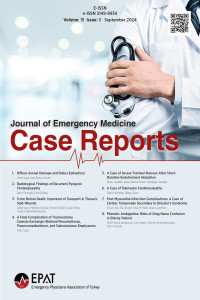Issue Editorial Board





Aim & Scope
Journal of Emergency Medicine Case Reports” (J Emerg Med Case Rep) is the official publication of the Emergency Medicine Physicians Association of Turkey. The journal implements “online-only” publication model and published mothly on the journal’s web page. The journal accepts manuscripts written in English.
Scope of Journal of Emergency Medicine Case Reports:
Journal of Emergency Medicine Case Reports is an Open Access, peer-reviewed journal that considers original and interesting case reports and brief reports that have contributed to medical field. The manuscript should cover at least one of these categories below:
- Mystery cases
- New or unusual illnesses
- Presentations, diagnoses and/or management of new and emerging diseases
- Important clinical situations that must be kept in mind
- Pitfalls
- New associations or variations in disease processes
- New diagnostic procedures
- An unexpected association between diseases or symptoms
- An unexpected event in the course of observing or treating a patient
- Findings that shed new light on the possible pathogenesis of a disease or an adverse effect
- Unexpected or unusual presentations of a disease or trauma process
- New treatment modalities (new drug/approach; new trends for known drug/approach)
- Using new medical technologies
- Patient complaints and/or malpractice
- Unreported or unusual side effects or adverse interactions involving medications
- Radiological screening and photographs: impressive and clinically important teaching materials that should not exceed 250 words
Author Guidelines
Format of manuscripts:
All manuscripts must be written in English, double-spaced with adequate margins on each side. The size and the writing style of the main text should be Arial 10 font. The text of the manuscript should not normally exceed 2000 words and include no more than 10 references and 3 figures or tables.
The manuscript should include the following:
- Title page that includes writer details (will be entered into the system)
- Abstract (will be entered into the system)
- Introduction (full text file)
- Case Report (full text file)
- Discussion (full text file)
- Conclusion (full text file)
- References (full text file)
- Informed consent form (will be sent by mail)
- Conflict of interest (also as a file)
- Contributions of the writers (also as a file)
- Acknowledgments (also as a file)
Title page:
Please provide a concise and informative title. The title page should include a list of all contributing authors and all of their affiliations. Positions of authors and names of departments and institutions to which they are attached and the province should be written. Supply full correspondence details for the corresponding author, including phone, mobile phone, fax number and e-mail address. A manuscript can not be signed by more than 5 authors unless it is approved by the editorial board prior to submission.
Abstract:
For submissions from Turkey, the manuscript should include an English abstract. Please provide an abstract of 200 words or fewer. Abstract should include these three separate structured paragraphs:
- Introduction
- Case Report
- Conclusion
This part should not include any reference to the text.
Introduction:
Should be brief and set out the purposes for which the study has been performed along with relevant previous scientific studies only wherever essential and necessary.
Case Report:
Clearly state these main study objectives below:
- Demographic characteristics
- Medical and family history
- History of pregnancy or delivery for females
- Cigarette, alcohol and drug use and their amounts (or doses)
- Symptoms and physical examination findings
- Procedures done for diagnosis and treatment
- Expectable and unexpectable results
- Prognosis of the patient
If more than one case will be represented, these objectives should be given for each case.
Discussion:
Should include additional data about the case and possible implications should be discussed. Discussion should be directly related to the study being reported. Do not include a general review of the topic only. An in-depth and insightful discussion in regarding to the new findings is encouraged.
Conclusion(s):
Should include clinical implications of the case(s) and important results.
Patient consent form - Ethics:
Our policy is to obey traditional medical and social ethical rules and adhering to confidentiality requirements specified in Constitution of the Republic of Turkey.
If a manuscript includes knowledge about a patient’s personal medical data that must be kept in secret, authors must be able to provide written confirmation that the patient described in the case report has given his/her informed consent for publication. This form can be acquired from the web address of Journal of Emergency Medicine Case Reports. After fulfilling this form, it must be sent to editorial office via fax or e-mail (after scanning). If the patient is in pediatric age group, the form must be signed by his/her legal guardian.
If patient consent form cannot be taken from the patient or reaching to the patient is impossible, than the data must be written anonymously without describing the patient. Anonymous data mean that the given knowledge should not describe a special patient and should not include secrets of a patient. Due to anonymousation, the probability of loss of data or argument is high. Thus, at the end of the manuscript, these sentences should be added: “The case report has written in an anonymous characteristic, thus secret and detailed data about the patient has removed. Editor and reviewers can know and see these detailed data. These data are backed up by editor and by reviewers.” In extreme conditions, the writers name may be included in this anonymousation.
If the patient has died, the statute of preserving the data is not valid. However, the writers can take permission from the patient’s close relatives for the purposes of considerateness and medical ethics. If making a connection with the relatives is impossible, the editorial team will examine the scientific value of the paper. If the scientific value is high, than the editorial team will make a decision about publishing the paper without consent. This publishing politics is also valid for other medical documents such as photographs and medical histories.
Patient Photographs:
Our general policy is to take permission from patients whose photographs will be published. If the identity of the patient can be understood from the photograph that will be published, than written consent is definitely needed. Photographs of radiological screenings, laparoscopic views, ultrasonographic images, pathology slides or a patological image of a certain body part can be used without permission of the patient if the identity of the patient is not understood or if no name, no sign and no determinant about his/her identity is given in the image.
Conflict of interest:
If any of the writers have a relationship based on self-interest, this should be explained.
Authorship criteria:
All persons designated as authors should qualify for authorship, and all those who qualify should be listed. Each author should have participated sufficiently in the work to take public responsibility for appropriate portions of the content.
Acknowledgments:
Only acknowledge persons who have made substantial contributions to the study, but was not a writer of the paper.
References:
Number references consecutively in the order in which they first appear in the text. In the text, references should be cited by numerals in brackets and without miniaturizing. Only list the literature that is published, in press (with the name of the publication known) or with a DOI number in references. References should conform to the updated style used in “Uniform Requirements for Manuscripts Submitted to Biomedical Journals”. Journal names should be abbreviated according to Index Medicus. List all authors up to six. When there are more than six authors, list only first six and add et al.
Follow the styles shown in examples below:
Journal Articles: Lewin MR, Stein J, Wang R, Lee MM, Kernberg M, Doe J, et al. Humming is as effective as Valsalva’s maneuver and Trendelenburg’s position for ultrasonographic visualization of the jugular venous system and common femoral veins. Ann Emerg Med 2007; 50: 73-7.
Book Chapters: Gary B. Green Peter M. Hill Approach To Chest Pain. In Judith E. Tintinally, MD, MS, Editor. Emergency Medicine. 6th ed. New York: McGraw-Hill; 2004. p.333-43.
Tables, Figures, Graphics and Photographs:
All tables, figures and graphics should be numbered in the text in order. For photographs and tables, desired positions must be explained in the text. Electron and light micrographs must have a scale marker and the staining technique used must be written. For patient photographs, written consent signed by the patient and/or parents’ should be added or patient’s face or eyes must be concealed so as not to be recognized by others.
Copyright Transfer Form
Author Contribution Form
Ethical Principles and Publication Policy
An approval of research protocols by Ethics Committee in accordance with international agreements (World Medical Association Declaration of Helsinki “Ethical Principles for Medical Research Involving Human Subjects”, amended in October 2013, www.wma.net ) is required for some case reports. If required, ethics committee reports or an equivalent official document may be requested from the authors. For manuscripts concerning experimental research on humans, a statement should be included that shows informed consent of patients and volunteers was obtained following a detailed explanation of the procedures that they may undergo. Information on patient consent, name of the ethics committee and the ethics committee approval number should also be stated in the manuscript. It is the authors’ responsibility to carefully protect the patients’ anonymity. For photographs that may reveal the identity of the patients, releases signed by the patient or their legal representative should be enclosed.
Price Policy
Ücretsizdir.


